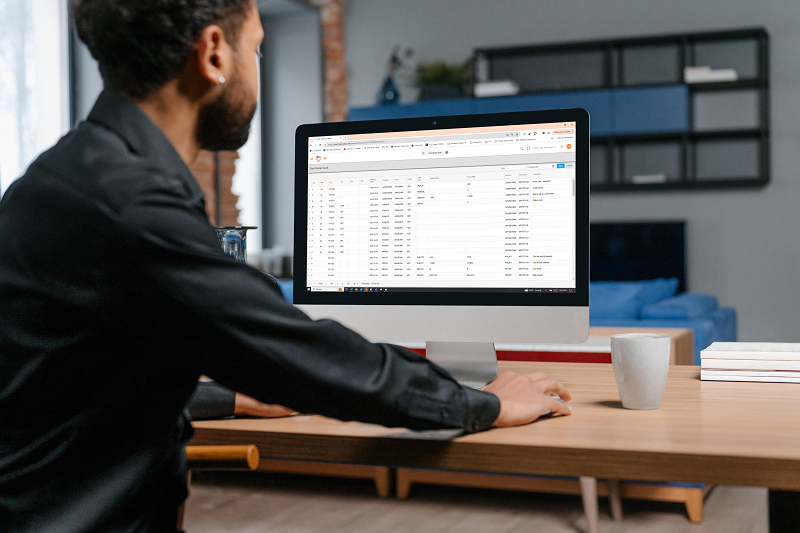The Power of Apparel ERP System Implementation

In the fast-paced and highly competitive world of apparel, efficient management of operations is critical for success. Apparel and footwear ERP software (Enterprise Resource Planning) has emerged as a game-changer for fashion businesses, providing a comprehensive and integrated solution to streamline processes, enhance productivity, and boost profitability.
Let's explore what a successful ERP implementation process entails and how it can significantly improve business operations.
Understanding Apparel ERP Implementations:
Apparel enterprise software implementation refers to the process of integrating an ERP system specifically designed for the apparel and fashion industry into their business. This robust software solution encompasses various functionalities such as inventory management, production planning, supply chain management, sales, and financials, all tailored to meet the unique needs of the apparel sector.
Benefits of Apparel ERP Implementation:
Streamlined Operations
By implementing an apparel ERP system, fashion businesses can streamline their operations from design to delivery. The software provides a centralized platform where different departments can collaborate, ensuring real-time data access and efficient communication. This streamlining enables faster decision-making, minimizes errors, and enhances overall operational efficiency.
Efficient Inventory Management
Inventory management is crucial in the apparel industry, where changing trends and seasons require careful management of stock. Apparel ERP implementation provides accurate and real-time inventory visibility, enabling businesses to optimize stock levels, minimize overstocking or shortages, and align inventory with customer demands. This results in reduced carrying costs, improved cash flow, and enhanced customer satisfaction.
Enhanced Production Planning
Efficient production planning is key to meet customer demands, minimize lead times, and reduce production costs. Apparel ERP systems facilitate effective production planning by providing insights into production capacity, raw material availability, and production schedules. This enables businesses to optimize production processes, allocate resources effectively, and meet delivery deadlines consistently.
Manufacturing
In the realm of fashion and apparel manufacturing, precision is paramount. Fashion manufacturing software, integrated seamlessly into our ERP solution, takes production planning to the next level. It empowers businesses to fine-tune manufacturing processes with real-time data on production capacity, material availability, and scheduling. This level of detail allows for meticulous resource allocation, minimizing waste and ensuring that every step of the manufacturing journey aligns with customer demands and delivery deadlines. With the fusion of Apparel ERP for manufacturing industry software, your production processes become a well-orchestrated symphony of efficiency and excellence.
Improved Supply Chain Management
The fashion industry relies heavily on a complex network of suppliers and partners. Apparel ERP implementation enables seamless supply chain management by integrating various stakeholders, automating processes, and providing visibility into supplier performance and lead times. This streamlines procurement, reduces costs, minimizes delays, and ensures a smooth flow of materials and products throughout the supply chain.
Data-Driven Decision Making
Apparel ERP systems capture and analyze vast amounts of data, providing valuable insights for informed decision-making across all business processes. Businesses can leverage these insights to identify trends, analyze sales performance, evaluate profitability, and make data-driven strategic decisions. This empowers fashion businesses to adapt quickly to changing market dynamics, optimize pricing strategies, and stay competitive in the industry.
New Apparel ERP Implementation Process: Planning and Execution
The planning and execution of a successful ERP implementation is a crucial process that requires careful consideration and meticulous execution with a project team. Here are the key steps involved in successful implementations:
New Apparel ERP System Needs: Assessment and Goal Definition
Begin the ERP implementation project by assessing your business's specific needs and goals. A typical erp implementation plan includes Identifying pain points, challenges, and areas for improvement within your current operations. Set clear objectives and erp software options for the new system, such as streamlining processes, improving inventory management, or enhancing supply chain visibility.
Vendor Selection and Chosen Erp Software
Conduct thorough research to identify reputable ERP software vendors specializing in the apparel industry. Evaluate their offerings based on functionality, scalability, industry experience, and customer reviews. Shortlist vendors and erp solutions that align with your business processes and requirements and schedule demos to assess their software's capabilities.
Apparel ERP Project Team Formation and Resource Allocation
Form a dedicated project implementation team consisting of key stakeholders from various departments and business functions for the new erp system implementation project. This team will be responsible for overseeing the implementation process, coordinating with the ERP provider and project manager, and ensuring smooth communication across the organization.
Gap Analysis and Customization
Perform a gap analysis as a part of the erp implementation process to identify the gaps between your business processes and requirements and the ERP software's out-of-the-box capabilities. Work closely with the ERP for garment industry vendor to customize the software to meet your specific needs, as they have performed many erp implementations. Define software development requirements, such as unique reporting formats, workflows, or integration with existing systems.
Data Migration and Cleanup
Data migration involves transferring existing data from legacy systems or spreadsheets to the new ERP solution. Cleanse and validate the migrated data to ensure accuracy and consistency. Collaborate with the ERP vendor to establish a data migration plan, including data mapping, transformation, and testing.
End User Training and Change Management
Develop a comprehensive training plan to ensure all users understand the new ERP system and its functionalities. Provide training sessions for employees across different departments, focusing on their specific roles and responsibilities. Additionally, implement change management strategies to address any resistance to the new system and ensure a smooth transition.
Testing and System Validation
Conduct extensive testing to validate the functionality and reliability of the ERP software. Test different scenarios, processes, and integrations to identify and resolve any issues or discrepancies. Perform user acceptance testing (UAT) to involve end-users in testing the system and gathering feedback.
Go-Live and Post-Implementation Support
Once the new ERP system has been thoroughly tested and validated, it's time to go live. Set a go-live date and execute the system rollout with the implementation team. Provide post-implementation support to address any immediate issues, provide user support, and gather feedback for further system enhancements.
Ongoing Monitoring and Optimization
Regularly monitor the ERP system's performance across all business processes, collect user feedback, and address any issues or optimization opportunities that arise. Continuously refine and improve processes, workflows, and configurations to ensure the ERP system remains aligned with evolving business needs.
By following these steps within a proper erp implementation plan and closely collaborating with the ERP solution vendor, your apparel business can successfully execute the implementation of ERP software, paving the way for improved operations, increased efficiency, and enhanced business growth.
From Implementation to Ongoing Support, Success Begins with ABS
Apparel ERP implementations offer a multitude of benefits for apparel and fashion businesses seeking to enhance their operations and drive growth. Apparel Business Systems offers the software and services that will allow you to streamline processes, optimize inventory, improve production planning, and strengthen supply chain management. Fashion and apparel businesses can improve efficiency, reduce costs, and deliver exceptional customer experiences with the ABS apparel management software. As the fashion industry continues to evolve, embracing a successful implementation is increasingly crucial for businesses aiming to stay ahead of the competition and achieve long-term success.
With over 40 years serving the unique needs of apparel and footwear companies of all sizes, ABS understands apparel erp and warehouse management implementation success - and that's the tip of the iceberg. Contact us to learn more about how the ABS apparel ERP software can set your business up for success. Info@apparelbusiness.com










